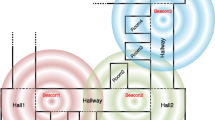Abstract
In ubiquitous computing, diverse media technologies have recently been extensively researched and applied to various fields. The goal of media technologies is to improve our daily lives by enabling us to control active media devices such as smart phones, tablets, and TVs. The locations of users are important to providing a variety of services to users. In addition, given that all devices cannot be simultaneously utilized, and only one device is sometimes being used, the location information can be utilized to help determine one of the core active media devices at a specific instant in time. This paper proposes an active media-control interface that is based on location recognition methods using beacons in indoor ubiquitous computing. In the proposed environment, users have a beacon that denotes the location of each user. The one that is the nearest from the beacon is selected from among multiple active media devices for servicing. In the experiments, four access points and one beacon was used to validate the proposed method. The advantage of the proposed method is that it enables us to apply active media technology to indoor environments. By recognizing user locations in indoor environments, several kinds of active media services become available.









Similar content being viewed by others
References
Kim, P.Y., Sung, Y., Park, J.H.: Bayesian probability-based motion estimation method in ubiquitous computing environments. In: The 10th International Conference on Ubiquitous Information Technologies and Applications, Cebu, Philippines, Dec. 15–17 (2015)
Sung, Y., Kim, J.W., Park, H.J., Park, K.M.: Levenshtein distance-based posture comparison method for cardiopulmonary resuscitation education. In: The 10th International Conference on Ubiquitous Information Technologies and Applications, Cebu, Philippines, Dec. 15–17 (2015)
Potter, L.E., Araullo, J., Carter, L.: The leap motion controller: a view on sign language. In: Proceedings of the 25th Australian Computer-Human Interaction Conference: Augmentation, Application, Innovation, Collaboration, pp. 175–178 (2013)
Zhang, L., Sturm, J., Cremers, D., Lee, D.: Real-time human motion tracking using multiple depth cameras. In: 2012 IEEE/RSJ International Conference on Intelligent Robots and Systems, pp. 2389–2395 (2012)
Lee, H.C., Lee, D.M.: A study on localization system using 3D triangulation algorithm based on dynamic allocation of beacon node. J. Korea Inf. Commun. Soc. 36(4), 378–385 (2011)
Lee, H.C., Lee, D.M.: The 3-dimensional localization system based on beacon expansion and coordinate-space disassembly. J. Korea Inf. Commun. Soc. 38B(1), 80–86 (2013)
Taysheng, J.: Advanced ubiquitous media for interactive space. Computer Aided Architectural Design Futures, pp. 341–350 (2005)
Jacucci, G., Peltonen, P., Morrison, A., Salovaara, A., Kurvinen, E., Oulasvirta, A.: Ubiquitous media for collocated interaction, part of the series computer supported cooperative work, pp. 23–45 (2009)
Kim, P.Y., Kim, J.W., Sung, Y.: Bayesian probability-based hand property control method. In: International Conference on Intelligent Technologies and Engineering Systems (ICITES 2014), Kaohsiung, Taiwan, December 19–21 (2014)
Lee, D., Helal, S., Sung, Y., Anton, S.: Situation-based assess tree for user behavior assessment in persuasive Telehealth. IEEE Trans. Human-Mach. Syst. 45(5), 624–634 (2015)
Want, R., Hopper, A., Falcao, V., Gibbons, J.: The active badge location system. ACM Trans. Inf. Syst. (TOIS) 10(1), 91–102 (1992)
Liu, H., Darabi, H., Banerjee, P., Liu, J.: Survey of wireless indoor positioning techniques and systems. IEEE Trans. Syst. Man Cybernet. C 37(6), 1067–1080 (2007)
Bahl, P., Padmanabhan, V.N.: RADAR: an in-building RF-based user location and tracking system. In: Proceedings of 19th Annual Joint Conference of the IEEE Computer and Communications Societies (INFOCOM ’00), Vol. 2, pp. 775–784, Tel Aviv, Israel, March 2000
Chen, Y., Kobayashi, H.: Signal strength based indoor geolocation. In: Proceedings of the IEEE International Conference on Communications (ICC ’02), Vol. 1, pp. 436–439 (2002). New York, NY, USA
Feng, C., Au, W.S.A., Valaee, S., Tan, Z.: Received-signal-strength-based indoor positioning using compressive sensing. IEEE Trans. Mobile Comput. 11(12), 1983–1993 (2012)
Sung, Y., Kwak, J.: Real-time Beacon distance revision method in indoor environment. Adv. Sci. Technol. Lett. 106, 69–72 (2015)
Sung, Y., Kwak, J., Jeong, Y., Park, J.H.: Beacon distance measurement method in indoor ubiquitous computing environment. In: The 4th International Conference on Ubiquitous Computing Application and Wireless Sensor Network (UCAWSN-15), Jeju, Korea, July 8–10 (2015)
Kwak, J., Jang, H., Sung, Y., Jeong, Y.: Improved location estimation method of trilateration in ubiquitous computing indoor environment. In: The 7th International Conference on Computer Science and its Applications, 15–17 Dec 2015, Cebu, Philippines
Acknowledgments
This research was supported by the MSIP (Ministry of Science, ICT and Future Planning), Korea, under the ITRC (Information Technology Research Center) support program (IITP-2015-H8501-15-1014) supervised by the IITP (Institute for Information & Communications Technology Promotion).
Author information
Authors and Affiliations
Corresponding authors
Rights and permissions
About this article
Cite this article
Sung, Y., Jeong, YS. & Park, J.H. Beacon-based active media control interface in indoor ubiquitous computing environment. Cluster Comput 19, 547–556 (2016). https://doi.org/10.1007/s10586-016-0532-6
Received:
Revised:
Accepted:
Published:
Issue Date:
DOI: https://doi.org/10.1007/s10586-016-0532-6




